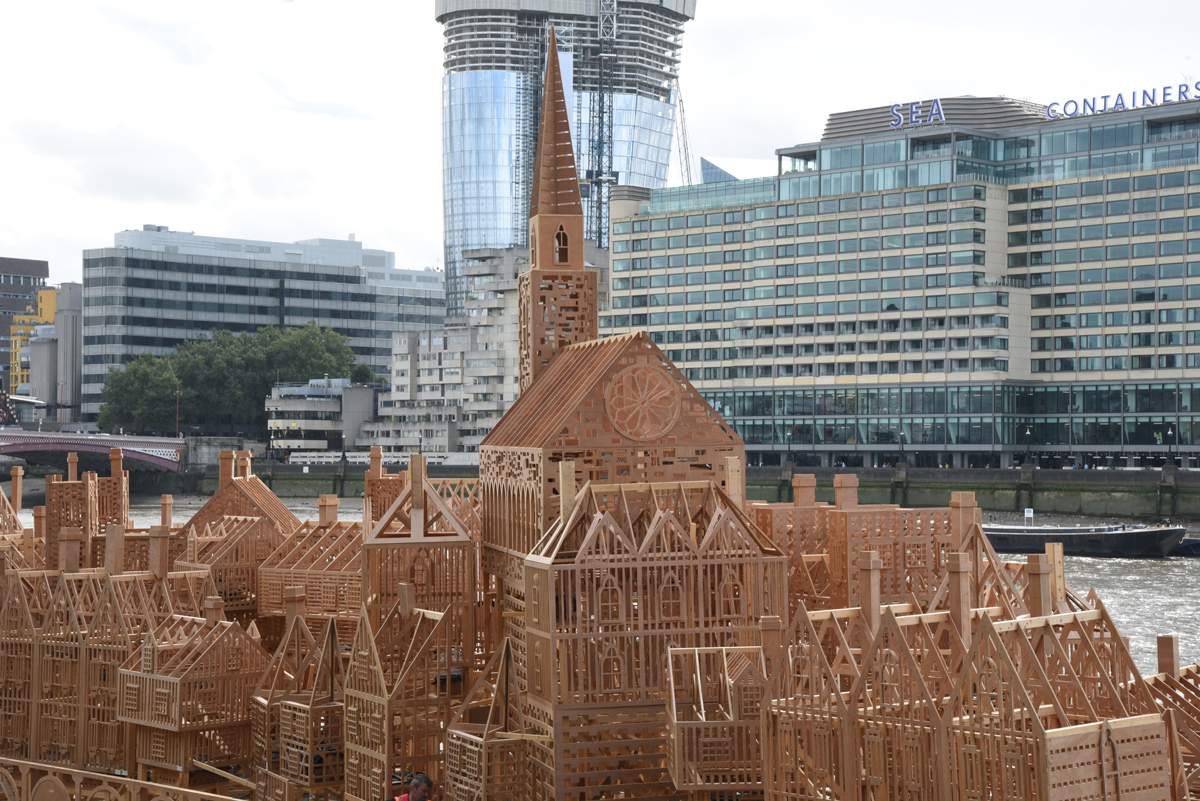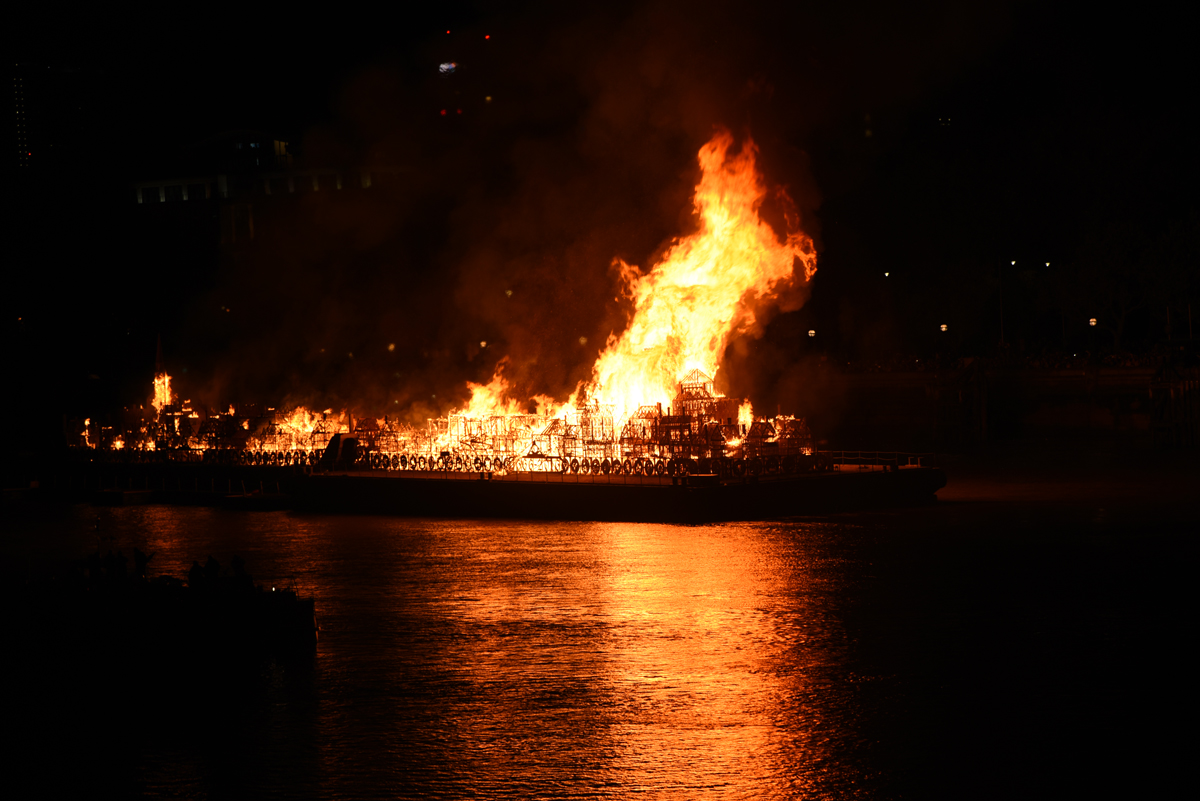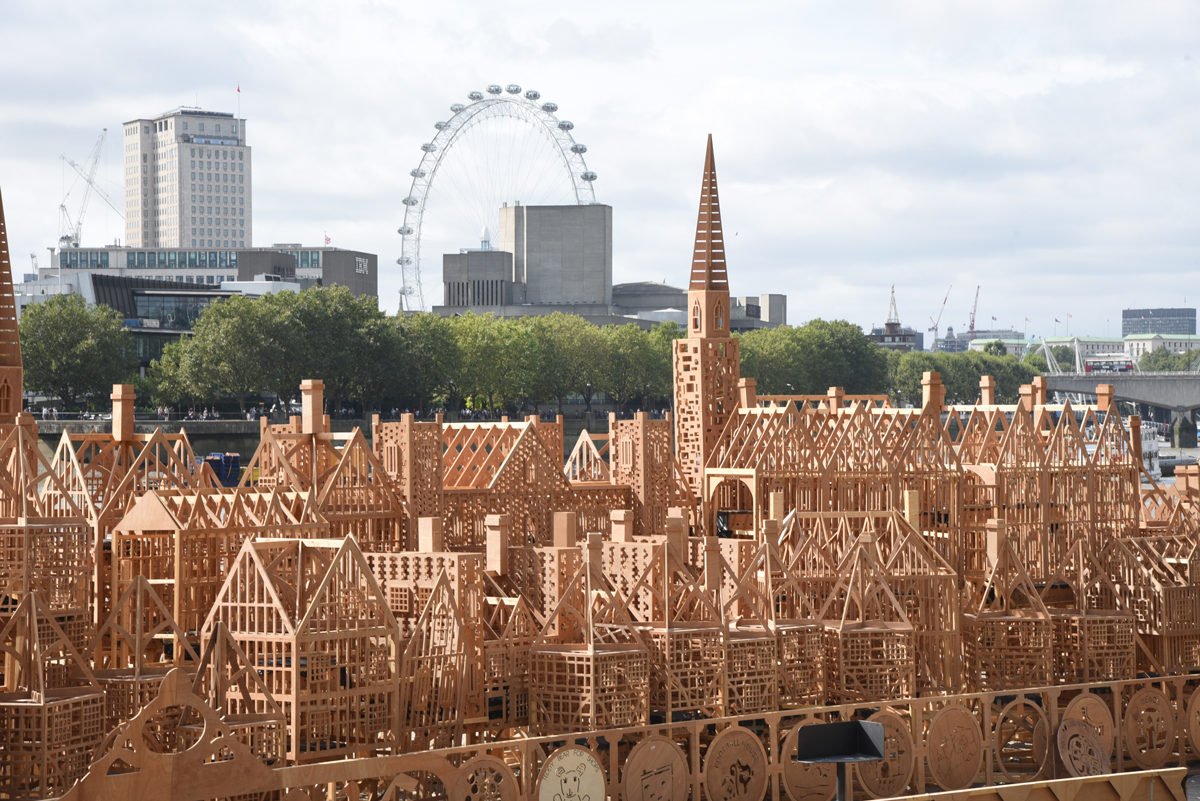AS THE WHOLE REPLICA CITY OF LONDON BURNT DOWN BEFORE THE EYES OF THOUSANDS, ISSUES BEGAN GROANING OUT THROUGH THE CREAKING SOUNDS
It is not often that a whole city burns, although much of Fort McMurray did in Canada in 2016 from a fierce forest fire. On 4th September 2016 – the 350th anniversary of the 1666 Great Fire of London – a magnificent 120 metres long wooden replica of the original 17th century walled city, moored on the River Thames, was deliberately set on fire. It raised some burning issues for today’s built environment. London’s 1666 skyline model, designed by David Best and built by schoolchildren for the ‘London’s Burning – Great Fire 350’ project on the Thames.
When London burned from 2nd to 5th September 1666, about 436 acres of the city were destroyed, including 13,200 houses and 84 churches, vividly described by Samuel Pepys in his famous diaries. However only 6 people died but more than 100,000 people were left homeless for years. Pepys described ‘10,000 houses all in one flame’, most of which were wooden and thatched houses in a totally chaotic and very overcrowded area. There was no fire service and the authorities were slow to act. It changed London for ever.

Thousands watched the replica skyline of old London burn on 4th September 2016. The Great Fire gave way to both good and bad consequences. On the one hand the fire cleared slums and the architect Sir Christopher Wren was able to oversee the redesign of the city including such iconic buildings as St Paul’s Cathedral. But the fire did no good for wood, which was virtually banned by building regulations for the next three centuries or more. Whereas in the USA and Scandinavia wood has been a prime construction material throughout history, it was impossible to obtain a bank loan in Britain for any home not built in bricks and mortar until quite recently. The real consequence is that for all this time financiers, developers, architects and engineers have ignored what we now know as the most environmentally beneficial construction material, low in embodied energy, storing atmospheric carbon and requiring less energy to construct – wood.
There are other issues too. When wood burns it tends to form insulating charcoal outside and maintain the integrity of the structure for some time. Firemen will tell you that a life-size building on fire, constructed of wood, will creak, speak and groan before it finally fails. There are other advantages. Twenty years ago the world-renowned engineers Arup showed that the volume to strength ratio of laminated American white oak was superior to steel, when wood was specified forPortcullis House atrium roof at Westminster in London. This reduced the volume of support sections thus allowing more light into the courtyard below. Building technology for wood is advancing fast with high-rise buildings literally growing all over the world from Australia to Canada and now also in London. A turning point for the UK came in 1999 when the Building Research Establishment (BRE) built a 6-storey building and burned it under test. The fire was contained and regulations to prohibit wooden structures were then relaxed. The burning of this magnificent model of the old city in London made of softwood and Chinese poplar plywood, surrounded by its competing materials of steel, concrete and glass, was a reminder of the end of some prejudice against the increased use of wood in construction.

แม้ว่าจะมีกรณีอย่าง Fort McMurray ในแคนาดาที่เสียหายจากไฟป่าอย่างรุนแรงไปเมื่อกลางปีก่อน แต่เหตุการณ์ไฟไหม้ที่สามารถทำลายเมืองทั้งเมืองได้นั้นก็ไม่ได้เกิดขึ้นบ่อยนัก วันที่ 4 กันยายน 2016 คือวันครบรอบ 350 ปี ของเหตุการณ์ไฟไหม้ครั้งใหญ่ในลอนดอนที่เกิดขึ้นในปี 1666 (Great Fire of London) และในวันดังกล่าวโมเดลไม้ที่จำลองเมืองลอนดอนสมัยเมื่อครั้งเต็มไปด้วยอาคารบ้านเรือนในศตวรรษที่ 17 ก็ถูกนำามาวางตัวเรียงกันยาวกว่า 120 เมตร บนแม่น้ำ Thames ก่อนถูกจุดไฟเผาอย่างตั้งใจ และในขณะที่โมเดลดังกล่าวกำลังลุกอยู่ในกองเพลิงนั้นเอง หลายประเด็นเกี่ยวกับสิ่งแวดล้อมที่มนุษย์เป็นผู้สร้างขึ้นในปัจจุบันก็ถูกจุดให้ร้อนแรงขึ้น
ย้อนไปเมื่อ 350 ปีก่อน มหาอัคคีภัยครั้งประวัติศาสตร์กินเวลาตั้งแต่วันที่ 2 ถึง 5 กันยายน 1666 มันส่งผลให้พื้นที่กว่า 436 เอเคอร์ของเมืองถูกทำลายลง รวมไปถึงบ้าน 13,200 หลัง และโบสถ์กว่า 84 แห่ง ไฟไหม้ใหญ่ครั้งนั้นคร่าชีวิตคนไป 6 คน และส่งผลให้ผู้คนมากกว่า 100,000 คน กลายเป็นคนไร้บ้านอยู่หลายปี Samuel Pepys เขียนไว้ในบันทึกอันโด่งดังของเขาว่า “บ้านเป็นหมื่นหลังลุกไหม้ขึ้นเป็นเปลวไฟหนึ่งเดียว” อาคารส่วนใหญ่เป็นบ้านไม้และมุงหลังคาด้วยฟางทั้งหมดตั้งอยู่อย่างแออัดในพื้นที่วุ่นวายไร้ระเบียบปราศจากบริการสาธารณภัย อย่างอัคคีภัยที่ถูกต้อง และทางการก็ดำาเนินการแก้ไขช้าเกินไป ในที่สุด ไฟไหม้ครั้งนั้นจึงเปลี่ยนลอนดอนไปตลอดกาล
เหตุการณ์ดังกล่าวก่อให้เกิดผลลัพธ์ทั้งที่ดีและร้าย ในมุมหนึ่งไฟครั้งนั้นล้างบางชุมชนแออัดอย่างราบคาบ ทำให้สถาปนิก Sir Christopher Wren สามารถเข้าไปออกแบบผังเมืองขึ้นใหม่ทั้งหมด รวมไปถึงอาคารสำคัญ อย่าง St Paul’s Cathedral แต่ในขณะเดียวกัน ไฟก็ทำให้ไม้ กลายเป็นวัสดุที่ถูกแบนโดยกฎหมายก่อสร้างอาคารเป็นเวลายาวนานต่อเนื่องกว่าสามศตวรรษ ในขณะที่ สหรัฐอเมริกาและประเทศในแถบสแกนดิเนเวียใช้ไม้เป็นหนึ่งในวัสดุหลักมาตลอดประวัติศาสตร์การก่อสร้างอาคาร ในอังกฤษ บ้านที่ไม่ได้สร้างด้วยอิฐและหินจะไม่มีวันได้รับเงินกู้จากธนาคาร ก่อนจะมีความเปลี่ยนแปลงเกิดขึ้นเมื่อไม่นานมานี้ ผลลัพธ์ที่แท้จริงก็คือ ตลอดเวลาที่ผ่านมา นายทุน นักพัฒนา สถาปนิก และวิศวกรได้มองข้ามสิ่งที่เป็นที่ประจักษ์ตอนนี้แล้วว่า วัสดุก่อสร้างที่เป็นประโยชน์ต่อสิ่งแวดล้อมมากที่สุดมีพลังงานสะสมรวม (Embodied Energy) ต่ำ ไม่ปล่อยก๊าซเรือนกระจก และใช้พลังงานในการก่อสร้างน้อยกว่าวัสดุอื่น ก็คือ “ไม้”
หนึ่งในประเด็นที่น่าสนใจก็คือเมื่อไม้ถูกเผา คุณสมบัติของความเป็นถ่านที่เกิดขึ้นกับพื้นผิวภายนอกจะช่วยรักษาโครงสร้างเอาไว้ได้ในระยะเวลาหนึ่ง สิ่งที่นักดับเพลิงทุกคนจะเล่าให้คุณฟังก็คืออาคารไม้ขนาดเท่าของจริงที่กำาลังถูกไฟไหม้อยู่นั้นจะส่งเสียง พูดคุย และครวญครางก่อนที่มันจะพังลง ข้อดีอื่นๆ ก็ยังมีเช่นกัน เมื่อยี่สิบปีที่แล้ว บริษัทวิศวกรรมระดับโลกอย่าง Arup แสดงให้เราเห็นว่าวัสดุไม้อย่าง American White Oak นั้นมีความแข็งแกร่งเหนือกว่าเหล็ก และมันก็ถูกเลือกเป็นวัสดุในการก่อสร้างหลังคาเอเทรี่ยมของ Portcullis House ใน Westminster ลอนดอนที่ซึ่งไม้ช่วยลดปริมาตรของส่วนโครงสร้างรับน้ำหนักอันส่งผลให้แสงธรรมชาติเข้าถึงคอร์ทด้านล่างได้มากขึ้น
เทคโนโลยีการก่อสร้างด้วยไม้กำลังพัฒนาไปอย่างรวดเร็วพร้อมๆกับการเกิดขึ้นของอาคารสูงทั่วโลก ตั้งแต่ออสเตรเลียไปจนถึงแคนาดาและลอนดอน จุดเปลี่ยนสำหรับอังกฤษเกิดขึ้นในปี 1999 เมื่อ Building Research Establishment (BRE) สร้างอาคารสูง 6 ชั้นและเผามันทิ้งเพื่อทดสอบ ผลลัพธ์ที่ได้ก็คือไฟถูกควบคุมไว้ได้และระเบียบข้อบังคับต่างๆ ก็ได้รับการผ่อนปรนลง ดังนั้นการจุดไฟเผาโมเดลอันงดงามของเมืองลอนดอนเก่าที่ทำขึ้นจากไม้เนื้ออ่อนและไม้อัดป๊อบลาร์จีนที่ล้อมรอบไปด้วยวัสดุคู่แข่งอย่างเหล็ก คอนกรีต และกระจกที่คลาคล่ำเนื้อเมืองของลอนดอน นับเป็นเครื่องเตือนความจำถึงจุดจบของอคติบางอย่างที่ต่อต้าน การใช้ไม้ในการก่อสร้างได้เป็นอย่างดี
TEXT: MICHAEL BUCKLEY MPHIL FIWSC
PHOTO COURTESY OF MICHAEL BUCKLEY
visitlondon.com/greatfire350

